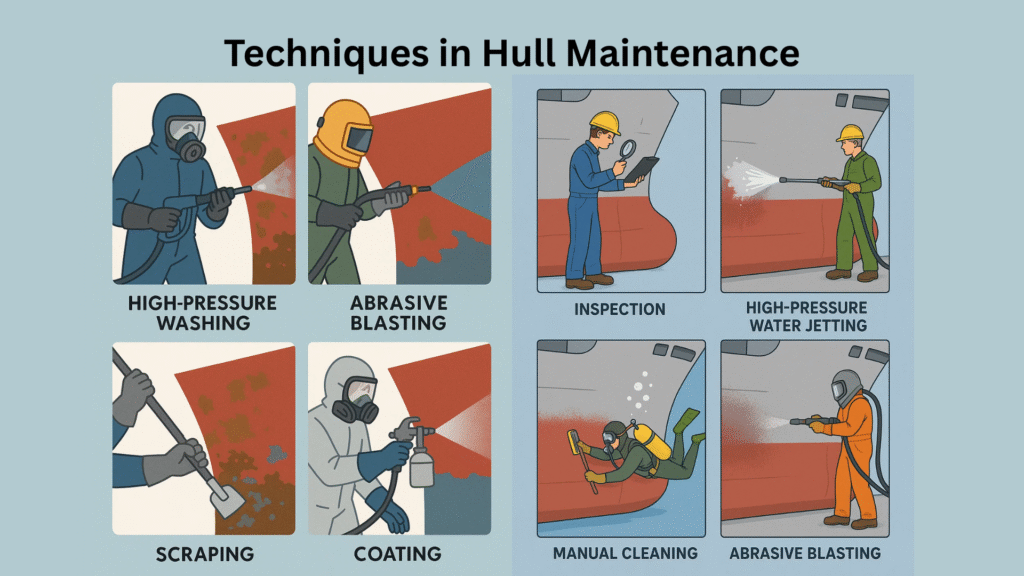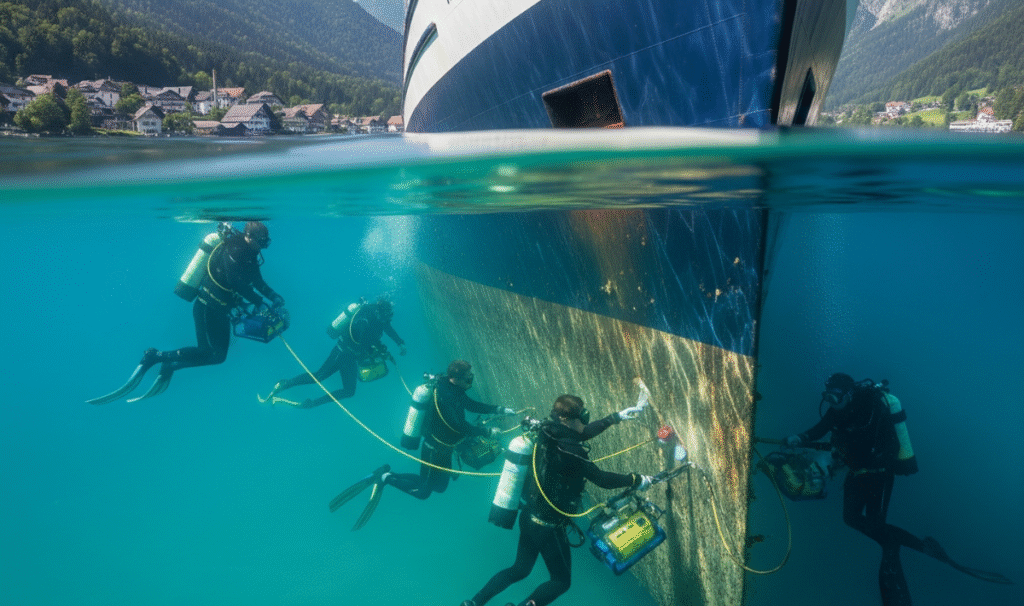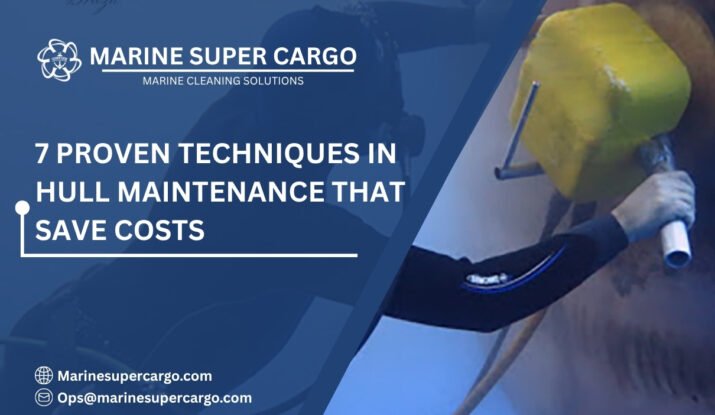Keeping a ship’s hull clean is like keeping its lungs clear—it breathes better, moves faster, and spends less fuel. But unlike lungs, hulls don’t clean themselves. That’s where diving techniques in hull maintenance have come a long way. From early manual scrubbing to today’s eco-friendly and compliance-driven solutions, we’ve seen an evolution that has shaped safety, performance, and sustainability for ship operators worldwide.
In this article, we’ll journey through that transformation, unpack different techniques in hull maintenance, and explore what lies ahead.
Why Techniques in Hull Maintenance Matter
If techniques in hull maintenance are neglected, a vessel pays a heavy price in drag, fuel waste, and even legal trouble. Barnacles, algae, and biofouling organisms attach themselves stubbornly to hulls, much like unwanted passengers.
Consequences include:
- Increased fuel consumption due to higher resistance.
- Higher emissions risk of MARPOL non-compliance.
- Shortened coating and hull lifespan.
- Costly dry-docking and unplanned downtimes.
This is why diverse techniques in hull maintenance have developed over the years—securing performance and protecting marine ecosystems.

A Glimpse into Early Diver Methods
Back in the mid-20th century, diving for hull cleaning was rough, risky, and primitive. Divers used brushes, scrapers, or simple pneumatic tools—not exactly safe or efficient.
- Manual scraping: Entirely diver-powered, extremely laborious.
- Early pneumatic brushes: Faster but prone to coating damage.
- Minimal environmental regulation: Discharge of fouling was common.
For context, the International Maritime Organization (IMO) had not yet advanced today’s strict biofouling management guidelines. Safety oversight was limited too, with IMCA standards still evolving.
Risks to Divers
Imagine balancing underwater currents, poor visibility, and heavy gear—all while trying to scrub barnacles off a moving steel wall. Early techniques in hull maintenance often exposed divers to:
- Hypothermia from long dives.
- Nitrogen narcosis at deeper depths.
- Dangerous encounters with ship propellers or hull suction effects.
These challenges forced the industry to innovate.
Transition to Safer Diving Technologies
By the late 20th century, professional associations like IMCA began publishing safety codes. Divers gained access to better breathing apparatus, communication systems, and hydraulically driven cleaning tools.
Key advancements included:
- Surface-supplied diving systems: Constant air supply, safer than traditional scuba.
- Hydraulic brushes and polishers: More efficient for large hull areas.
- Closed-circuit collection units: Prevented fouling waste from polluting harbors.
These improvements marked a turning point, making hull cleaning safer and more compliant than before.
Major Techniques in Hull Maintenance
Today, techniques in hull maintenance have transformed into a mix of manual expertise, technology, and environmental awareness. Each method has unique benefits and drawbacks.
Traditional Diver Cleaning
Divers still play a role, especially in ports where robotic systems aren’t available or cost-effective.
- Pros: Flexible for spot-cleaning, cheaper in smaller ports.
- Cons: Human risk factors, variable cleaning outcomes, potential for coating damage.
This method relies on physical effort, though supported by advanced hydraulic or electric tools.
Robotic Hull Cleaning
Rising environmental scrutiny drove the emergence of robotic cleaners—essentially “underwater Roombas” for ships.
- Automated magnetic crawlers: Equipped with rotating brushes.
- Suction-based robots: Use high-pressure jets without harming coatings.
- Waste capture: Many designs include filtration systems, keeping waste from entering the sea.
These modern techniques in hull maintenance are faster, safer, and environmentally responsible.
Compliance and Environmental Factors
Ship operators today don’t just face cost issues—they also face strict biofouling regulations.
IMO and MARPOL Standards
The IMO’s biofouling guidelines push for preventive hull cleaning. MARPOL Annex V prohibits the uncontrolled release of certain biofouling waste into the ocean, emphasizing eco-friendly practices.
Port Authorities and Global Pressures
Ports under IAPH (International Association of Ports and Harbors) demand stricter compliance. For instance, New Zealand and Australia have strict port-state controls on biofouling. Non-compliance may mean vessel delays or penalties.
Thus, using sustainable techniques in hull maintenance is no longer optional but a legal responsibility.
Cost-Saving Benefits of Proper Maintenance
Investing in optimized cleaning saves shipowners millions annually. A fouled hull can spike fuel costs by up to 40%.
Benefits include:
- Longer gaps between dry-docking.
- Reduced carbon footprint, meeting ESG expectations.
- Fuel savings of 5–20% per voyage.
- Improved coating life, reducing repair costs.
In other words, clean hull, clean profits.
Comparing Old vs. Modern Practices in Hull Cleaning
The world of hull cleaning has transformed dramatically over the past 50 years. What was once a labor-intensive, risky process has evolved into a highly technical and environmentally conscious operation.
Then: Traditional Methods
In the past, hull cleaning relied heavily on human divers manually scrubbing the underwater surfaces with brushes and hand tools. Safety measures were minimal, making it a dangerous job prone to accidents. Environmental considerations were almost non-existent—discharge of fouling organisms and chemicals directly into the water was uncontrolled, leading to ecological harm. Maintenance was reactive, carried out only when fouling visibly affected ship performance.
#maritimecleaning #hullcleaning #diversafety #marinesafety #supercargo#ShipMaintenance #MarineCleaning #EcoFriendlyShipping #FuelEfficiency #BiofoulingControl #SustainableShipping #UnderwaterCleaning #VesselPerformance #MaritimeOperations pic.twitter.com/OqJAyu8oCX
— Marine Super Cargo (@Marinsupercargo) September 2, 2025
Now: Modern Practices
Today, hull cleaning is guided by technology, regulation, and sustainability. Remotely operated vehicles (ROVs) and autonomous robots perform cleaning tasks with precision, minimizing risks to human life. Operations adhere to IMCA (International Marine Contractors Association) safety standards to ensure diver safety when manual intervention is necessary. Strict MARPOL compliance governs waste discharge, preventing environmental pollution. Maintenance is now predictive and scheduled, often integrated with data analytics to optimize hull performance and fuel efficiency.
Key Shift
The transition from survival-driven, reactive cleaning to sustainability-driven, proactive techniques in Hull Maintenance reflects the shipping industry’s commitment to safety, efficiency, and environmental stewardship. Modern techniques in hull maintenance not only protect vessels but also contribute to lower fuel consumption, reduced emissions, and compliance with global maritime regulations.
Case Examples from Industry
- Tanker vessels in the 80s often lost weeks waiting for diver cleaning, costing thousands daily.
- Today, container ships use robotic hull cleaners mid-port call, completing jobs within 8–12 hours without significant downtime.
This efficiency reflects real-world advantages driving adoption.
Future Innovations
AI-Driven Predictive Hull Cleaning Robots
The next wave of hull cleaning goes beyond scrubbing—autonomous, AI-powered robots use sensors, cameras, and machine learning to detect fouling at a microscopic level and predict where it will occur.
Smart Functions:
- Diagnose coating damage, cracks, and erosion for proactive maintenance.
- Upload real-time inspection data to fleet dashboards for drag estimates, compliance (IMO CII, EEXI), and predictive schedules.
Key Advantages:
- Reduced diver risk.
- Minimal downtime—cleaning at anchor/berth.
- Fuel savings and extended coating life.
Nanotechnology-Based Hull Coatings
Nanotech coatings create super-smooth, water-repellent surfaces that prevent fouling. Some contain active nanoparticles for self-polishing, continuously refreshing the hull and reducing cleaning frequency.
Key Benefits:
- Longer-lasting, eco-friendly, non-toxic alternatives to traditional antifouling paints.
- Lower biofouling-related drag, reduced maintenance costs, and extended dry-docking intervals.
- Supports IMO decarbonization by lowering CO₂ emissions.

The Combined Future Vision
Imagine a fully integrated system where a ship’s hull is coated with nano-based self-polishing layers, and AI-driven robots monitor it continuously. Instead of costly, periodic maintenance, hull cleaning could become predictive, automated, and minimally invasive.
This synergy between robotics and nanotechnology represents the next frontier in sustainable shipping—cutting costs, reducing downtime, and achieving environmental compliance.
Conclusion
Diving methods in hull cleaning have transformed from manual survival jobs to highly regulated, eco-friendly, and technologically enhanced operations.
Key takeaways:
- Modern techniques in hull maintenance improve fuel savings, compliance, and safety.
- Robotic solutions and better coatings are shaping greener shipping.
- Future-proofing techniques in hull maintenance involve adapting to new technologies early on.
For keeping fleets efficient, compliant, and environmentally sound, working with experienced providers is essential. To explore innovative solutions, visit CleanShip.co today.
FAQ:
Q1. Why is hull cleaning so important for ships?
Hull cleaning prevents fuel waste, reduces drag, and helps ships stay compliant with MARPOL and port-state regulations. It also extends coating and hull lifespan.
Q2. How often should techniques in hull maintenance be carried out?
Depending on the route and waters, this is usually every 3–6 months. Heavily fouled or tropical waters may require more frequent inspections.
Q3. Are robotic hull cleaning systems cost-effective?
Yes. They reduce downtime, improve efficiency, and prevent pollution fines, making them highly cost-effective over time.
Q4. What risks do divers face in hull cleaning?
Divers risk hypothermia, poor underwater visibility, nitrogen narcosis, and physical injury from vessels, especially without modern safety systems.
Q5. What does the future hold for hull cleaning?
AI-enabled robots, self-cleaning hull coatings, and data-driven predictive monitoring are expected innovations in hull maintenance.


